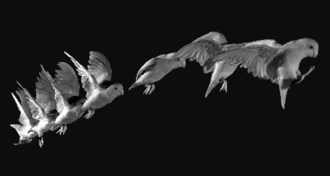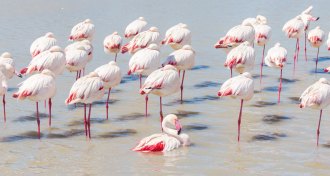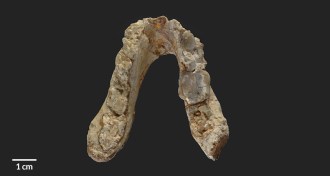All Stories
-
 Animals
AnimalsPetite parrots provide insight into early flight
High-speed video shows that tiny parrots direct their hops to use the least amount of energy necessary.
-
 Health & Medicine
Health & MedicineDrugs for reflux disease in infants may come with unintended consequences
Infants prescribed proton-pump inhibitors for reflux disease may be at higher risk for broken bones later on.
-
 Life
LifeHow a flamingo balances on one leg
Flamingos’ built-in tricks for balance might have a thing or two to teach standing robots or prosthesis makers someday.
By Susan Milius -
 Planetary Science
Planetary ScienceTRAPPIST-1’s seventh planet is a chilly world
Follow-up observations of TRAPPIST-1 and its seven planets reveals details about the outermost one.
-
 Planetary Science
Planetary ScienceTRAPPIST-1’s seventh planet is a chilly world
Follow-up observations of TRAPPIST-1 and its seven planets reveals details about the outermost one.
-
 Archaeology
ArchaeologyTool sharpens focus on Stone Age networking in the Middle East
Stone Age tool’s route to Syrian site covered at least 700 kilometers.
By Bruce Bower -
 Life
LifeMouse sperm survive space to fertilize eggs
Sperm freeze-dried and sent into space for months of exposure to high levels of solar radiation later produced healthy baby mice.
-
 Life
LifeMouse sperm survive space to spawn
Sperm freeze-dried and sent into space for months of exposure to high levels of solar radiation later produced healthy baby mice.
-
 Health & Medicine
Health & MedicineOlder adults may not benefit from taking statins
Statins did not reduce heart attacks, coronary heart disease deaths or deaths from any cause in people age 65 and older, a new analysis finds.
-
 Anthropology
AnthropologyEuropean fossils may belong to earliest known hominid
With new analyses of Graecopithecus fossils from Greece and Bulgaria, researchers argue for possible hominid origins in Europe, not Africa.
By Bruce Bower -
 Health & Medicine
Health & Medicine40 more ‘intelligence’ genes found
A study of nearly 80,000 people turns up 40 genes that may have a role in making brains smarter.
-
 Health & Medicine
Health & MedicineEven short-term opioid use can set people up for addiction risks
A study of opioid prescriptions for sprained ankles finds that patients prescribed 30 or more pills are more likely to seek refills.
By Laura Beil